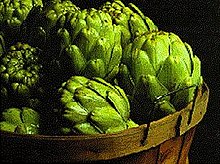 The Globe Artichoke (Cynara cardunculus) is a perennial thistle originating in Southern Europe around the Mediterranean. It grows to 1.4–2 m tall, with arching, deeply lobed, silvery glaucous-green leaves 50–82 cm long. The flowers develop in a large head from an edible bud about 8–15 cm diameter with numerous triangular scales; the individual florets are purple. The edible portion of the buds consists primarily of the fleshy lower portions of the involucral bracts and the base, known as the "heart"; the mass of immature florets in the center of the bud is called the "choke". These are inedible in older larger flowers.
The Globe Artichoke (Cynara cardunculus) is a perennial thistle originating in Southern Europe around the Mediterranean. It grows to 1.4–2 m tall, with arching, deeply lobed, silvery glaucous-green leaves 50–82 cm long. The flowers develop in a large head from an edible bud about 8–15 cm diameter with numerous triangular scales; the individual florets are purple. The edible portion of the buds consists primarily of the fleshy lower portions of the involucral bracts and the base, known as the "heart"; the mass of immature florets in the center of the bud is called the "choke". These are inedible in older larger flowers. Today, Globe Artichoke cultivation is concentrated in the countries bordering the Mediterranean basin. The main producers are Italy, Spain, and France. In the United States, California provides nearly 100% of the U.S. crop, and approximately 80 percent of that is grown in Monterey County; there, Castroville proclaims itself to be "The Artichoke Center of the World", and holds an annual artichoke festival.
Today, Globe Artichoke cultivation is concentrated in the countries bordering the Mediterranean basin. The main producers are Italy, Spain, and France. In the United States, California provides nearly 100% of the U.S. crop, and approximately 80 percent of that is grown in Monterey County; there, Castroville proclaims itself to be "The Artichoke Center of the World", and holds an annual artichoke festival.Cooking
In the US, large globe artichokes are most frequently prepared for cooking by removing all but 5–10 mm or so of the stem, and (optionally) cutting away about a quarter of each scale with scissors. This removes the thorns on some varieties that can interfere with handling the leaves when eating. Then, the artichoke is boiled or steamed until tender. If boiling, salt can be added to the water, if desired. It may be preferable not to cover the pot while the artichokes are boiled, so that the acids will boil out into the air.
Covered, and particularly cut artichokes can turn brown due to the acids and chlorophyll oxidation. If not cooked immediately, placing them in water lightly acidulated with vinegar or lemon juice prevents the discoloration. Leaves are often removed one at a time and the fleshy base part eaten, sometimes dipped in hollandaise, vinegar, butter, mayonnaise, aioli, lemon juice or other sauces, the fibrous upper part of each leaf being discarded; the heart is then eaten when the inedible choke has been discarded after being carefully peeled away from the base. The thin leaves covering the choke are mostly edible.
 In Italy, artichoke hearts in oil are the usual vegetable for spring in the 'Four Seasons' pizza (with olives for summer, mushrooms for autumn and prosciutto for winter). In Spain, the more tender younger and smaller artichokes are used. They can be sprinkled with olive oil and left in hot ashes in a barbecue, sauteed in olive oil with garlic, with rice as a paella or sauteed and combined with eggs in a tortilla (frittata). More often cited are the Greek artichokes (a la polita), of which probably the finest examples are to be found on the island of Tinos.
In Italy, artichoke hearts in oil are the usual vegetable for spring in the 'Four Seasons' pizza (with olives for summer, mushrooms for autumn and prosciutto for winter). In Spain, the more tender younger and smaller artichokes are used. They can be sprinkled with olive oil and left in hot ashes in a barbecue, sauteed in olive oil with garlic, with rice as a paella or sauteed and combined with eggs in a tortilla (frittata). More often cited are the Greek artichokes (a la polita), of which probably the finest examples are to be found on the island of Tinos. Often thrown away, the cores of artichoke stems, once the fibrous exterior has been discarded, are perfectly edible and taste like the artichoke heart. Artichokes can also be made into a herbal tea; artichoke tea is produced as a commercial product in the Da Lat region of Vietnam. Artichoke is the primary flavor of the Italian liqueur Cynar.
Often thrown away, the cores of artichoke stems, once the fibrous exterior has been discarded, are perfectly edible and taste like the artichoke heart. Artichokes can also be made into a herbal tea; artichoke tea is produced as a commercial product in the Da Lat region of Vietnam. Artichoke is the primary flavor of the Italian liqueur Cynar.Cynarin, an active chemical constituent in Cynara, causes an increased bile flow. The majority of the cynarin found in artichoke is located in the pulp of the leaves, though dried leaves and stems of artichoke also contain cynarin.
This diuretic vegetable is of nutritional value because of its exhibiting aid to digestion, strengthening of the liver function, gall bladder function, and raising of HDL/LDL ratio. This reduces cholesterol levels, which diminishes the risk for arteriosclerosis and coronary heart disease. Aqueous extracts from artichoke leaves have also shown to reduce cholesterol by inhibiting HMG-CoA reductase and having a hypolipidemic influence, lowering blood cholesterol. Artichoke contains the bioactive agents apigenin and luteolin.
Reference : http://en.wikipedia.org/wiki/Artichoke









0 comments:
Post a Comment